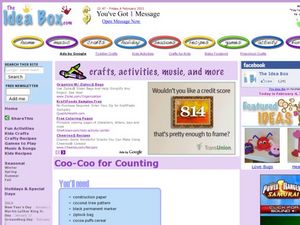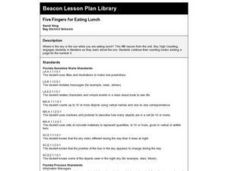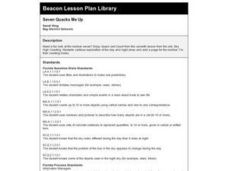Curated OER
Cultural Calendar
Students design their own cultural calendar. In this calendar making instructional activity, students decide on a culture for a calendar theme and discuss how calendars differ from the US calendar. Students create their own calendar...
Curated OER
Using Proper Tools to Solve Problems-Pre Test
In this using proper tools worksheet, students answer a set of 10 multiple choice questions. Students may click on a link to see answers and may print worksheet out.
Curated OER
Coo Coo for Counting
Students put coconut trees in order from numbers 1 through 10 that appear on each tree. In this ordering numbers lesson plan, students complete this activity after reading the book Chicka Chicka Boom Boom.
Curated OER
Lucky Charms Sort
Students make a bar graph. In this sorting and counting lesson, students use the Lucky Charms cereal to sort the marshmallows into separte cups, count how many marshmallows are in each cup and make a bar graph to compare the numbers.
Curated OER
Shape Sandwich
Students create sandwiches with an adult. In this shapes lesson, students are familiarized with shapes while making their sandwich.
Curated OER
Distance in Space
Sixth graders explore space science by measuring distances between planets. In this solar system lesson, 6th graders view a Bill Nye video and discover the conversion between the metric system and imperial measuring systems. Students...
Curated OER
On Jupiter
Middle schoolers tour Jupiter. In this scenario based lesson, students examine the size of Jupiter and make models of the other planets in the solar system to show how large Jupiter is compared to the other planets.
Curated OER
Gravity - The Glue of the Universe
Students explore physics by conducting a class experiment. In this gravitational force lesson, students define several scientific terms associated with force. Students utilize a styrofoam cup and marbles to simulate a satellite crashing...
Curated OER
Spheres Multiple Choice
In this volume and surface area worksheet, students answer ten multiple choice questions concerning the volume and surface area of various spheres.
Curated OER
Building a Scale Model
Third graders create a model of the solar system. In this solar system lesson plan, 3rd graders create a scale model of the solar system. Working in pairs students solve mathematical problems to correctly measure the distance each planet...
Curated OER
The Probability Scale
Students collect data and make predictions. In this probability lesson, students perform experiments calculating the chance of an event occurring. They draw conclusion based on their data.
Curated OER
Incorporate Black History into Math
February is Black History Month. So why not highlight lessons that connect mathematics to Africans and African Americans?
Curated OER
IS MASS THE SAME AS WEIGHT?
Students see the difference between weight and mass when they examine the method of measuring each of them.
Curated OER
Sunrise/Sunset
Students apply data from a weather-related website to predict patterns in the sunrise and sunset.
Curated OER
Five Fingers for Eating Lunch
First graders listen to the book, The M&M's Brand Counting Book, discuss the one-to-one correspondence and count the candies in the story. They focus on the number five, and listen to the story Sun Up, Sun Down, discussing the...
Curated OER
Time, Tide, and Quahogs
Students read tide tables for Waquoit Bay as the simulate determining the best time to go clam digging for a Wampanoag clambake. They graph the tide tables while realizing that the tides a Waquoit Bay are one hour later than those at...
Curated OER
How Many?
In this book-making worksheet, students create a number and color book. Each page gives a picture of a group of items with a sentence. Students insert the correct number and trace the color word.
Curated OER
Seven Quacks Me Up
First graders explore the day and night sky and add a page for the number 7 to their countiing books.
Curated OER
Six Insect Legs
Learners observe and discuss the sun's position in the sky. They explore the number six, read various number books, and create the number six page for a counting book.
Curated OER
Kepler's Third Law
Learners use Kepler's third law to derive the velocity in a circular orbit of any radius, and identify the Earth escape velocity.
Curated OER
Trigonometric Applications Outside the Classroom
Fifth graders describe and demonstrate how trigonometry can be used to find the height of a tall building or tree. They describe and demonstrate how trigonometry can be used to find the height of a high hill, or other high object where...
Curated OER
Participants are challenged to create several different sorting groups for the set of images.
Learners examine the influence of interaction with other cultures and the environment in relation to calendars. They also look at the origins of the calendar we use every day.
Curated OER
Calendars
Second graders read books and discuss the names of the days of the week, months, and their holidays and seasons. They discover the concept of the days in order, practicing sequencing using a pocket chart and perform a matching activity...
Curated OER
Arranging the Elements
Students describe how elements are arranged in the periodic table. They compare metals, nonmetals, and metalloids based on their properties and on their location in the periodic table. Finally, students identify and describe the...
Other popular searches
- Moon Phases
- Phases of the Moon
- Owl Moon
- Moon Landing
- Earth Science Moon Phases
- Moon Phases Worksheets
- Sun and Moon
- Goodnight Moon
- The Moon
- Walk Two Moons
- Earth and Moon
- Earth Moon Sun System

























